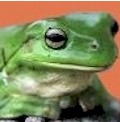The Australian Green Tree Frog, simply Green Tree Frog in Australia, White's Tree Frog, or Dumpy Tree Frog (Litoria caerulea) is a species of tree frog native to Australia and New Guinea, with introduced populations in New Zealand and the United States. The species belongs to the genus Litoria. It is physiologically similar to some species of the genus, particularly the Magnificent tree Frog (Litoria spendida) and the Giant Tree Frog (Litoria infrafrenata).
The Green Tree Frog is larger than most Australian frogs, reaching 10 centimeters (4 inches) in length. The average life span of the frog in captivity is about 16 years and is long compared with most frogs. Green Tree Frogs are docile and well suited to living near human dwellings. They often are found on windows or inside houses, eating insects by night.
Due to its physical and behavioral traits, the Giant Tree Frog has become one of the most recognizable frogs in its region, and is a popular exotic pet throughout the world. The skin secretions of the frog have antibacterial and antiviral properties that may prove useful in pharmaceutical preparations.
The Green Tree Frog can grow up to 10 centimeters (4 inches) in length. Its color depends on the temperature and color of the environment, ranging from brown to green; the ventral surface is white. The frog occasionally has small, white, irregularly shaped spots on its back, up to 5 millimeters in diameter, which increase in number with age. The frog has large disks at the ends of its toes, about 5 millimeters in diameter at maturity. These help the frogs grip while climbing and allow them to climb vertically on glass. The eyes are golden and have horizontal irises. The fingers are about one-third webbed, and the toes nearly three-quarters webbed. The tympanum (a skin membrane similar to an eardrum) is visible.
Although frogs have lungs, they absorb oxygen through their skin, and for this to occur efficiently, the skin must be moist. A disadvantage of moist skin is that pathogens can thrive on it, increasing the chance of infection. To counteract this, frogs secrete peptides that destroy these pathogens. The skin secretions from the Green Tree Frog contain caerins, a group of peptides with antibacterial and antiviral properties.
The Green Tree Frog is native to northern and eastern regions of Australia and to southern New Guinea. Distribution is limited mostly to areas with warm, wet tropical climate. In New Guinea, the Green Tree Frog is restricted to the drier, southern region.
Green Tree Frogs are very docile. They are nocturnal and come out in early evening to call (in spring and summer) and hunt at night. During the day, they find cool, dark, and moist areas to sleep. During the winter, Green Tree Frogs do not call and are usually not seen.
The species' diet consists mainly of insects and spiders, but can include smaller frogs and even small mammals. Frog teeth are not suited to cutting up prey, so the prey must fit inside the mouth of the frog. Many frogs propel their sticky tongues at prey. The prey sticks, and is consumed, Green Tree Frogs will use this technique for small prey, however for larger prey, it pounces, then forces the prey into its mouth with its hands. The frog has a few native predators, among them snakes and a few species of lizards and birds.
The Green Tree Frog is one of the most popular pet frogs throughout the world. Its docile nature, often cartoon-like appearance, and long life expectancy make it an attractive choice for exotic-pet owners. It is also one of the easier frogs to care for: their diet is broad and they have a strong resistance to disease. One problem commonly associated with keeping this species as a pet is overfeeding. Green Tree Frogs tend to become obese if overfed. In the wild, exertion of energy is required for a frog to capture its prey. However, in captivity they are usually given live feed in a confined space. This lessens the activity needed for feeding, resulting in weight gain. An overweight member of the species will deposit fat layers over the top of the head and body, giving it a "dumpy" appearance. Thus the name, "Dumpy Tree Frog."
